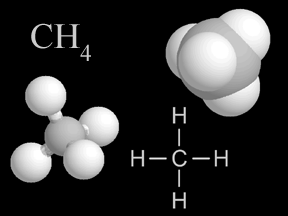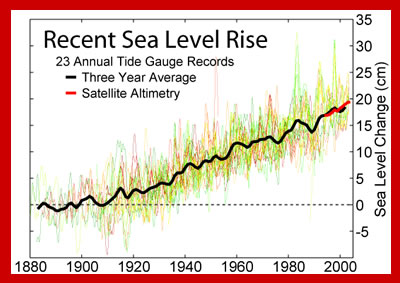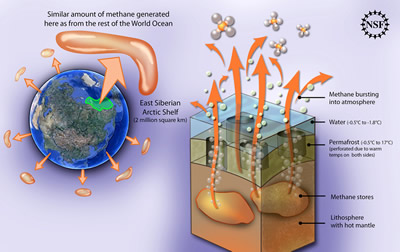The permafrost of the East Siberian Arctic Shelf (an area of about 2 million kilometers squared) is more porous than previously thought. The ocean on top of it and the heat from the mantle below it warm it and make it perforated like Swiss cheese. This allows methane gas stored under it under pressure to burst into the atmosphere. The amount leaking from this locale is comparable to all the methane from the rest of the world's oceans put together. Methane is a greenhouse gas more than 30 times more potent than carbon dioxide.
Click on image for full size
Image Courtesy of Zina Deretsky, National Science Foundation
Methane Is Being Released Much Faster Than Previously Thought from the Arctic Ocean
Natalia Shakhova and Igor Semiletov, scientists from the University of Alaska Fairbanks, have studied a section of the sea floor of the Arctic Ocean called the East Siberian Arctic Shelf. The results of their research show that the permafrost under this ice shelf is starting to leak large amounts of methane into the atmosphere.
Methane is a greenhouse gas that can be released from permafrost when the permafrost thaws on land or on the sea floor.
The East Siberian Arctic Shelf is shallow, which means it has been both under water and above water at different times during Earth's history. During the Earth's coldest periods, it is a frozen land and does not release methane. As the Earth warms and sea level rises, the shelf is covered with seawater, which is 12-15 degrees warmer than the average air temperature.
In the shallow water of the East Siberian Arctic Shelf, more methane escapes into the atmosphere. This can cause the climate to warm.
"The Arctic is a difficult place to get to and to work in, but it is important that we do so in order to understand its role in global climate and its response and contribution to ongoing environmental change," said Henrietta Edmonds of the National Science Foundation.
You might also be interested in:

This page is not yet developed at the elementary level. Please check back soon for updates or click on the "Intermediate" button above.
...more
Methane is a kind of gas. There is a small amount of methane in the air you breathe. A methane molecule has carbon and hydrogen atoms in it. Methane is a greenhouse gas. That means it helps make Earth
...more
Only a tiny amount of the gases in Earth’s atmosphere are greenhouse gases. But they have a huge effect on climate. There are several different types of greenhouse gases, but they all have something in
...more
Sea level is creeping higher each year as the Earth warms. As sea level continues to rise, there are many low coastal areas worldwide where homes, towns and cities are in danger of being flooded
...more
Scientists have learned that Mount Hood, Oregon's tallest mountain, has erupted in the past due to the mixing of two different types of magma. Adam Kent, a geologist at Oregon State University, says this
...more
The Earth's mantle is a rocky, solid shell that is between the Earth's crust and the outer core. The mantle is made up of many different reservoirs that have different chemical compositions. Scientists
...more
Some faults look strong and like they wouldn’t cause an earthquake. But it turns out that they can slip and slide like weak faults causing earthquakes. Scientists have been looking at one of these faults
...more















